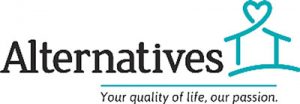March 30, 2017
Preparing your Home for “Aging in Place”
 By Alyssa Dominacki
By Alyssa Dominacki
Alternatives for the Older Adult
Business Development Coordinator
“We just don’t know whether to move into a smaller, more accessible home as we retire or whether we should do something with our current home to make it safer as we age.”
For many of us, we want to stay in our own home for as long as possible. Perhaps we raised our family, been in the same home for decades and/or just really like the comfort of our current space. We also know that as we age, our home can become a challenge to continue to live in safely and comfortably.
Preparing your home for the coming years, commonly referred to as Aging in Place, is a crucial step towards preventing safety concerns that tend to appear over time.
The biggest culprit? Falls. A fall usually will start the conversation about an older adult’s ability to stay in their home, particularly if there was a significant injury involved.
Every year one in three adults over age 64 will fall and more than two million will be treated for non-fatal fall injuries in emergency departments. “Half of falls occur in a person’s home. Falls are the main reason older people go to emergency departments,” says Steve Albert, PhD, co-director of the University of Pittsburgh Prevention Research Center (PRC) to the CDC.
As identified by The Joint Center for Housing Studies at Harvard University, here are five features that set the stage for a prepared home:
• no step entrance
• daily needs being able to completed on a single floor
• switches and outlets reachable whether standing or sitting,
• extra-wide doorways and hallways
• easy to use faucet handles
Certainly, three of these five work to prevent falls. But, there are other components of every home that begin to challenge us as our eyesight, mobility and hearing declines. It can sneak up on us. For 75 percent of adult children, they are both worried about their parents’ ability to live independently as they age and not sure where to begin with the conversation.
Emergency Room Doctors agree that an annual home safety assessment is important to keep seniors safe at home. A quality assessment will not only look at accessibility, but will tailor the recommendations to priorities and daily needs of the homeowner. It is important to talk through the daily struggles to develop the solutions that fit for the older adult.
There are a countless of solutions, from high tech (medication management machines, motion sensors, etc.) to low tech (landing table by the door, highlighted stair edges, etc.) Some may involve major construction (widen doorways or building ramps) or minor fixes that can be used at low to no cost. (Yes, you should remove the trip rugs from the top of the stairs!)
A professional home assessment can help identify areas to improve in your home that you may not have thought about. Preparing your home for “Aging in Place” is similar to the other retirement planning done throughout the years and recognizes there is just no place like home.
Alternatives, the local resource for older adults navigating the challenges of aging, is now introducing HouseCheck. Alternatives’ Home Modification Practitioners combine years of experience with specialized Home Modification training to provide prioritized recommendations through an in-home assessment.
Is your home ready to take care of you? Call today 1-800-798-0988
Filed Under: Family, Health & Wellness, News, Retirement
Trackback URL: https://www.50pluslife.com/2017/03/30/preparing-your-home-for-aging-in-place/trackback/


